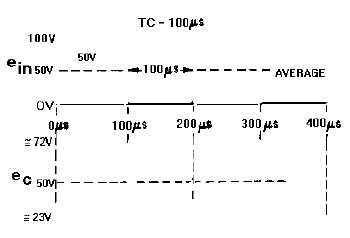4-42
4-37. The long, sloping rise and fall of voltage is caused by the inability of the capacitor to charge and
discharge rapidly through the 10,000-ohm series resistance.
Figure 4-37.—Medium time-constant integrator.
At the first instant of time, 100 volts is applied to the medium time-constant circuit. In this circuit,
1TC is exactly equal to the duration of the input pulse. After 1TC the capacitor has charged to 63.2
percent of the input voltage (100 volts). Therefore, at the end of 1TC (100 microseconds), the voltage
across the capacitor is equal to 63.2 volts. However, as soon as 100 microseconds has elapsed, and the
initial charge on the capacitor has risen to 63.2 volts, the input voltage suddenly drops to 0. It remains
there for 100 microseconds. The capacitor will now discharge for 100 microseconds. Since the discharge
time is 100 microseconds (1TC), the capacitor will discharge 63.2 percent of its total 63.2-volt charge, a
value of 23.3 volts. During the next 100 microseconds, the input voltage will increase from 0 to 100 volts
instantaneously. The capacitor will again charge for 100 microseconds (1TC). The voltage available for
this charge is the difference between the voltage applied and the charge on the capacitor (100 - 23.3
volts), or 76.7 volts. Since the capacitor will only be able to charge for 1TC, it will charge to 63.2 percent
of the 76.7 volts, or 48.4 volts. The total charge on the capacitor at the end of 300 microseconds will be
23.3 + 48.4 volts, or 71.7 volts.
Notice that the capacitor voltage at the end of 300 microseconds is greater than the capacitor voltage
at the end of 100 microseconds. The voltage at the end of 100 microseconds is 63.2 volts, and the
capacitor voltage at the end of 300 microseconds is 71.7 volts, an increase of 8.5 volts.
The output waveform in this graph (eC) is the waveform that will be produced after many cycles of
input signal to the integrator. The capacitor will charge and discharge in a step-by-step manner until it
finally charges and discharges above and below a 50-volt level. The 50-volt level is controlled by the
maximum amplitude of the symmetrical input pulse, the average value of which is 50 volts.
Long Time-Constant Integrator
If the resistance in the circuit of figure 4-35 is increased to 100,000 ohms, the time constant of the
circuit will be 1,000 microseconds. This time constant is 10 times the pulse duration of the input pulse. It
is, therefore, a long time-constant circuit.
The shape of the output waveform across the capacitor is shown in figure 4-38. The shape of the
output waveform is characterized by a long, sloping rise and fall of capacitor voltage.

